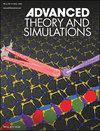利用迁移学习克服查克拉尔斯基晶体生长中的数据限制
IF 2.9
4区 工程技术
Q1 MULTIDISCIPLINARY SCIENCES
引用次数: 0
摘要
Czochralski (Cz)法是一种广泛用于生长高质量单晶的工艺,在半导体、光学和先进材料中应用至关重要。实现最佳生长条件需要精确控制工艺和炉膛设计参数。然而,数据稀缺——尤其是新材料——限制了机器学习(ML)在预测建模和优化中的应用。本研究提出了一种迁移学习方法,通过将在一种源材料(Si)的较高数据量上训练的ML模型适应于另一种目标材料(Ge和GaAs)的较低数据量,来克服这一限制。这些材料经过精心选择,以评估迁移学习方法在处理不同数据相似性方面的稳健性,其中Cz‐Ge与Cz‐Si相似,而GaAs通过液体封装的Czochralski方法(LEC)生长,与Cz‐Si不同。探讨了各种迁移学习策略,包括热启动、合并训练和超参数迁移,并评估了跨两种不同材料的多个机器学习架构。结果表明,迁移学习可以显著提高预测精度,并为优化不同材料的Cz生长参数提供了一个实用的框架。本文章由计算机程序翻译,如有差异,请以英文原文为准。
Leveraging Transfer Learning to Overcome Data Limitations in Czochralski Crystal Growth
The Czochralski (Cz) method is a widely used process for growing high‐quality single crystals, critical for applications in semiconductors, optics, and advanced materials. Achieving optimal growth conditions requires precise control of process and furnace design parameters. Still, data scarcity – especially for new materials – limits the application of machine learning (ML) in predictive modeling and optimization. This study proposes a transfer learning approach to overcome this limitation by adapting ML models trained on a higher data volume of one source material (Si) to a lower data volume of another target material (Ge and GaAs). The materials are deliberately selected to assess the robustness of the transfer learning approach in handling varying data similarity, with Cz‐Ge being similar to Cz‐Si, and GaAs grown via the liquid encapsulated Czochralski method (LEC), which differs from Cz‐Si. Various transfer learning strategies are explored, including Warm Start, Merged Training, and Hyperparameters Transfer, and evaluate multiple ML architectures across two different materials. The results demonstrate that transfer learning significantly enhances predictive accuracy with minimal data, providing a practical framework for optimizing Cz growth parameters across diverse materials.
求助全文
通过发布文献求助,成功后即可免费获取论文全文。
去求助
来源期刊

Advanced Theory and Simulations
Multidisciplinary-Multidisciplinary
CiteScore
5.50
自引率
3.00%
发文量
221
期刊介绍:
Advanced Theory and Simulations is an interdisciplinary, international, English-language journal that publishes high-quality scientific results focusing on the development and application of theoretical methods, modeling and simulation approaches in all natural science and medicine areas, including:
materials, chemistry, condensed matter physics
engineering, energy
life science, biology, medicine
atmospheric/environmental science, climate science
planetary science, astronomy, cosmology
method development, numerical methods, statistics
 求助内容:
求助内容: 应助结果提醒方式:
应助结果提醒方式:


